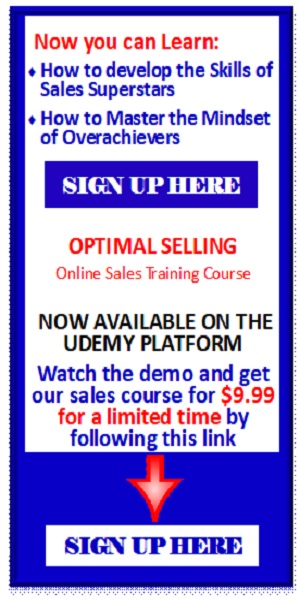If you want to sell better, buy better. We expect our buyers to buy the way we buy. If you are the type of person who shops around for the right deal, asking demanding questions of sellers, doing research, and comparing features and benefits, you are going to expect your buyers to do the same. If you tend to buy things on instinct, “feeling good” about a product or service without investigation, you are going to expect your buyers to purchase intuitively as well. If you believe your customers should buy from you after a careful analysis, make it a habit to become more analytical in your purchase decisions. On the contrary, if you believe your customers should buy from you based on the emotional appeal of your solution, allow your emotions to become a greater factor in your purchase decisions. Avoid sales frustration by aligning your purchase methodology with what you expect of your prospective customers.
Archives for April 2016
Test
Look for context of the prospect’s problem
The context of the prospect’s problem provides important details about the nature and importance of the problem. Make sure you understand the context in which the problem occurs before you move on in discussing the solution. A prospect tells you they had a flat tire this morning. Say something more than “I’m sorry to hear that.” Find out the context of the flat tire in the prospect’s life. Where did the flat tire occur? Was it on a busy street? Did they get help fixing the tire? Was it a nail or a pothole? Did they call for help? Did help arrive on time? Did it make them late for a meeting? How did it impact their day? How did it impact their goals? Did it create further problems for them? Can you imagine the opportunities that can be created by having this additional information? Maybe you can recommend a better route for the prospect to drive. Maybe you know a car repair service that could have helped. Maybe you have a solution that can help them get back on track with their goals for the day or solve problems the flat tire created. Get the context of the problem and not just the problem itself.
Look for reasons to say goodbye to prospect
Put your time and effort into prospects who are actually interested in your solution. A prospect that is truly going to buy your product or service will look for reasons to engage you in conversation about what you have to offer. They won’t miss a deadline. They won’t forget to follow through on a commitment. They won’t continuously reschedule meetings. They won’t be too busy and then fail to follow up. If you sense you are getting the brush off, you probably are. Be pessimistic. However, take charge! Ask the prospect to clarify their interest in your solution. If they demonstrate an interest, become optimistic and work to close the deal. If they affirm their lack of interest, say goodbye. Move on to the next prospect, the prospect who loves what you have to offer.
Price is a conceptual thing, not an objective thing
Price is a conceptual thing, not an objective thing. We tend to think of price as something fixed and objective. No matter how much a prospect desparately must have what we offer, we are certain they will never buy it if it costs more than a standard price they are willing to pay. If your product or service is greater than an established price, you are too expensive. If it is less, your solution is affordable. Throw that thinking away! Price is not objective. It is conceptual. Price is directly related to the pain your product or service eliminates. If a magic wand that would heal a loved one of a terminal disease is available for purchase for $ 1 million, you would find a way to raise that amount of money to buy that wand. Similarly, if your product or service resolves a huge problem a prospect is burdened with, they would pay a king’s ransom for your solution! Price is directly proportional to the pain that the item being purchased solves. Discover your prospect’s inner pain. Find a solution that your products or services offers to end that prospect’s pain. Feel good about the expense of what you have to offer. It’s worth the price! It solves a huge problem for a client! Price is conceptual – believe your solution solves the deep pain of prospects and you will know it is priceless.
Practice active listening
The optimal salesperson uncovers the facts and the emotions from a prospect. The weather forecast calls for 2 inches of rain tomorrow. John says “isn’t that wonderful?” He has been concerned there hasn’t been enough rain and his garden is struggling. He’s excited. Mark says “isn’t that wonderful?” He was looking forward to playing softball tomorrow with the guys from the church. The guy who usually starts at third base was out of town on a business trip. Now, with the game cancelled by rain, Mark won’t get a chance to play. The other guy will be back next week. Both men shared the fact that it will rain heavily tomorrow. Both men responded to the forecast with the same words. However, their emotions couldn’t have been more opposite. It’s not enough to get the facts from a prospect. You need the emotion. Emotions are revealed by tone of voice (Mark’s sarcasm, for example) and body language (John’s smile). The only place to get those forms of communication are in face-to-face meetings with prospects, when you practice active listening.

